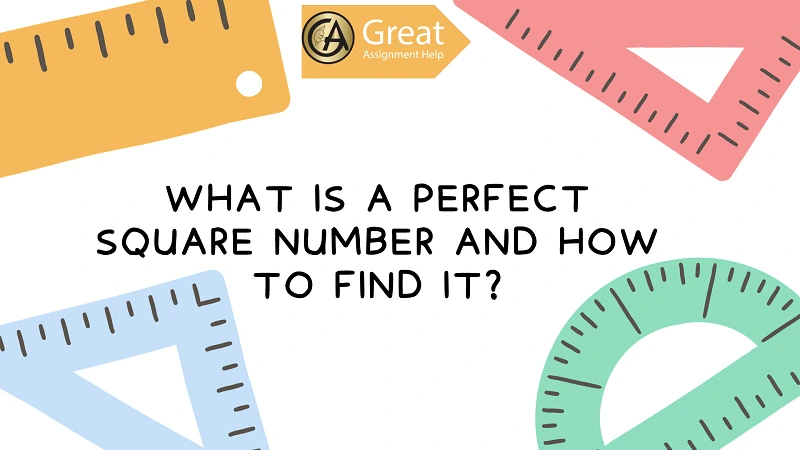When studying mathematics, you will often come across the term ‘perfect square number’. But do you know what it means? In case, you don’t know the answer to the question of what is a perfect square number, take a look at this blog. For your understanding, here, we have explained in detail about perfect square numbers with some examples. Also, we have shared how to identify a perfect square number. Continue reading and update your knowledge so that you can easily solve your math assignments on arithmetic.
What is a Perfect Square Number?
Numbers that are the products of integers by themselves are known as perfect square numbers. In other words, the result of multiplying an integer by itself is known as a perfect square of the given number.
When using the integer as the base number, the product of two equal integers can be written as an exponent, also known as an index or power of 2. This number is identified as the perfect square number’s square root. The inverse function of squaring an integer is called square rooting a number.
In simple terms, a positive whole number is said to be a perfect square if its square root is likewise a positive whole number. It is not a perfect square if the square root is a decimal. Note that, the square root of a number must be a rational number.
For example, 25 is a perfect square because it is the product of 5 by itself, i.e. 5 x5=25. A perfect square can be expressed as p2, where p is an integer.
Mathematical Definition of a Perfect Square Number
Here, let us look at the formal definition of a perfect square number in mathematics.
If a∈Z, then a perfect square number n such that n=a×a = a2 exists for all n∈N. Here, the integer ‘a’ is called the square root of n.
Note: As the integer set Z is closed under multiplication, every product of two integers belonging to Z likewise belongs to Z. This property holds because N is a subset of Z.
A perfect square ‘n’ is always a positive integer, although its square root ‘a’ might be either positive or negative.
For the sake of clarity, in this blog, we will exclusively consider perfect squares derived from the multiplication of positive integers, generally known as the subset of natural numbers N. As a result, a∈ N is assumed.
Also more recommend: What is a Variable in Math, its Types and Uses?
Properties of Perfect Square Numbers
All positive integer square numbers, regardless of size, have a few characteristics in common. These similarities are referred to as properties. Here let us see some of the important properties of perfect square numbers.
- The last digit will be 0, 1, 4, 5, 6, or 9.
- The digital root will always be any one of these numbers- 1, 4, 7, or 9.
- If the final digit is 6, then the penultimate digit must be odd.
- The penultimate digit will be an even number if the last digit is not 6.
- The penultimate digit must be 2 if the last digit is 5.
- In case, the last digit is zero, then the number will end with an even number of zeros.
- The even square numbers will have an even square root and the odd squares will have an odd square root.
- After dividing by 3, the remainder will be either 1 or 0.
- After dividing by 4, the remainder will be either 1 or 0.
- They usually contain an odd number of prime factors.
How to Find Out a Perfect Square Number
By using the properties listed above, you can identify whether a number is a perfect square or not. Remember, the number is not a perfect square if it lacks the required properties.
However, just because a number has some properties does not mean it is a perfect square. For example, 22 is not a square number, even though its digital root 2+2 is 4. Furthermore, the number terminates in 2, excluding it from consideration as a square number.
After finding the ideal perfect square, you can continue the process of identifying the integer square root. This is the primary method to find a perfect square. Note that, a number would be a perfect square if it has an integer square root.
Steps to Find the Square Root of a Number
You can identify the square root of a number by using an effective algorithm that includes the five simple steps mentioned below.
- If you are given a number ‘n’, then first group the final two digits of ‘n’ as a pair and place other numbers in a separate group.
- Keep in mind that the last digit of ‘n’ will notify you what will be the possible last digit of the square root ‘a’. You will receive two numbers however the single-digit square root of a perfect square will also contain the same final digit.
- Find the perfect square that is nearest to but smaller than the number group, omitting the pair. Calculate the square root. This digit will be in the square root of ‘a’, adjacent to the final digit, as decided in the next stages.
- Multiply by 1 more than the square root with the square root found in step 3.
- If the number identified in Step 4 is greater than the group of numbers, the smaller of the two numbers identified in Step 2 should be used as the last digit of a. In case, it is less, then pick the greater of the two values in step 2. Finally, by combining your answers, you will get the square root of the integer.
Another method that helps to find square roots involves factoring surds or prime factorization. You can even identify the values by using a calculator.
Also Read: What Comes After Trillion? Know about Large Numbers
List of Perfect Square Numbers
In the table below, get the list of natural numbers from 1 to 10 and their perfect squares.
| Natural Number | Perfect Square |
| 1 | 1 x 1 = 1 |
| 2 | 2 x 2 = 4 |
| 3 | 3 x 3 = 9 |
| 4 | 4 x 4 = 16 |
| 5 | 5 x 5 = 25 |
| 6 | 6 x 6 = 36 |
| 7 | 7 x 7= 49 |
| 8 | 8 x 8 =64 |
| 9 | 9 x 9 = 81 |
| 10 | 10 x 10 = 100 |
Also more recommend: What is a Constant in Math? Definition, Examples, and Solved Problems
Examples of Perfect Square Number Calculation
Below we have shared some sample problems on perfect squares. Look at the examples and update your knowledge.
Example 1
What is the perfect square of 15?
Solution
To find the perfect square, multiply the number by itself,
15 x 15= 225
Perfect square of 15= 225
Example 2
If a = √529. Find a.
Solution
Use the 5-step algorithm suggested above to find the value of a.
Step 1:√529 = √5 29
Step 2: Here, the last digit is 9. Hence, the possible last digit of the square root of 529 will be 3 or 7.
Step 3: 4 is the perfect square closest to but less than the value of 5. The square root of four is two. As a result, 2 is the first digit of the square root of a.
Step 4: Since the square root determined in step 3 was 2, and 2+1 = 3, 2 x 3 = 6.
Step 5: Because 6 > 5, we select 3 rather than 7 as the last digit of ‘a’.
As a result, a = √529 = 23.
Example 3
If a = √1444. Find a.
Solution
Step 1: √1444= √14 44
Step 2: Here, the last digit is 4. Hence, the possible last digit of the square root of 1444 will be 2 or 8.
Step 3: 9 is the perfect square closest to but less than the value of 14. The square root of nine is 3. As a result, 3 is the first digit of the square root of a.
Step 4: Since the square root determined in step 3 was 3, and 3+1 = 4, then 3 x 4 = 12.
Step 5: As 12 is less than 14, we choose 8 as the last digit of ‘a’.
Therefore, a= √1444 = 38
Also more recommend: Best Math Books To Augment Your Skills
Conclusion
By now, you will have understood what perfect square numbers are. In case, you still have any doubts about this concept or if you find it hard to solve your math assignments that are related to perfect square numbers, approach us immediately.



